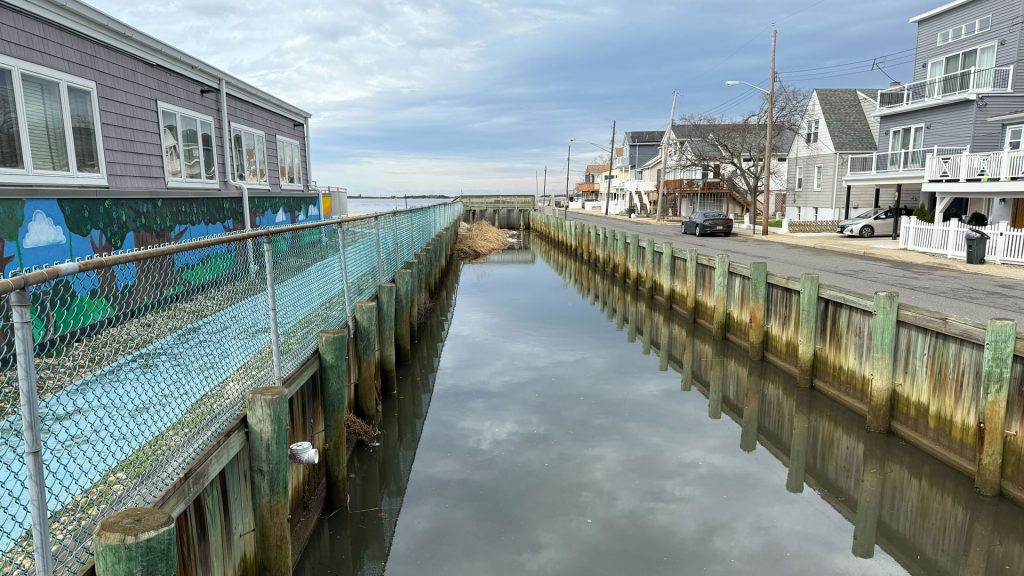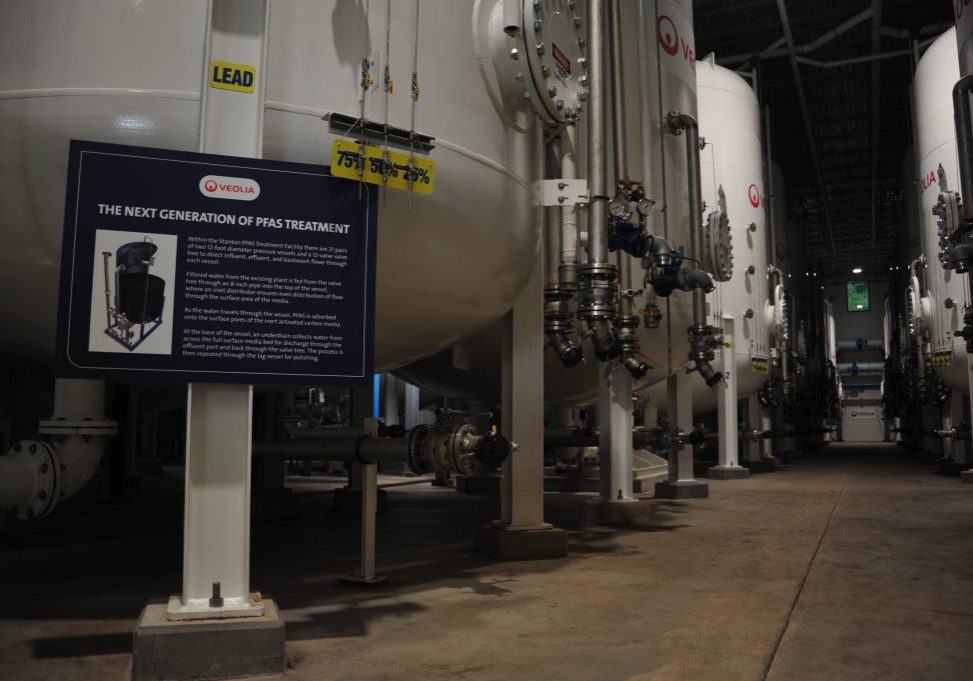
Trump cuts upend major NJ storm protection projects
| April 12, 2025
This story originally appeared on NJ Spotlight News.
The latest cut by the Trump administration to jeopardize community projects in New Jersey is a federal program designed to reduce future storm damages by investing in protective infrastructure nationwide.
The Federal Emergency Management Agency is ending the Building Resilient Infrastructure and Communities (BRIC) program, an initiative that in recent years awarded hundreds of millions of dollars in grants to make communities around the U.S. more resilient to future natural disasters.
Acting FEMA Administrator Cameron Hamilton sent an internal memo — first reported by Grist — announcing a “new direction” for the program. The memo was labeled as a pre-decisional draft, for “internal deliberative purposes.”
The move comes as Kristi Noem, the secretary of Homeland Security, has pledged to dismantle FEMA.
“Under Secretary Noem’s leadership, we are ending non-mission critical programs. BRIC was yet another example of a wasteful and ineffective FEMA program. It was more concerned with climate change than helping Americans effected by natural disasters,” a FEMA spokesperson said in a statement. “We are committed to ensuring that Americans in crisis can get the help and resources they need.”
Years of research contradict claims that resilience projects are wasteful spending. Policy experts commonly cite a figure from the National Institute of Building Sciences that every dollar spent by the federal government on storm resiliency saves $6 from future damage.
A report from the U.S. Chamber of Commerce published in June found that along with the savings in damage costs, each dollar spent on resiliency efforts saves an additional $7 in economic impacts — meaning that every dollar spent on resilience ultimately saves communities $13 when storms hit.
Shifting the burden
U.S. Rep. Frank Pallone (D-6th) called the decision to end the BRIC program “short-sighted and dangerous.”
“What’s happening here is part of a broader effort by the Trump administration to put all the burden of natural disaster preparation and recovery on the state and the towns instead of the federal government,” Pallone said in a statement to NJ Spotlight News.
The program was created as part of the Disaster Recovery Reform Act, which President Trump signed in 2018. It has been funded in recent years by the federal bipartisan infrastructure law, and it is possible that legal challenges will be filed against FEMA’s move to end the program.
Since the program began, 35 projects across New Jersey have been awarded grants totaling more than $180 million. Much of that money has been obligated, meaning it has either already been paid or is in the process of being paid by FEMA.
In Cape May County, the county Municipal Utilities Authority was awarded $20.7M to help build a new floodwall around the sewage treatment plant in Ocean City and related improvements. To date, just $1.5M of that grant has been obligated by FEMA.
But some major resiliency efforts around the Garden State currently have BRIC grants that are either mostly not obligated, or not obligated at all. The future of those projects is now unclear.
Cape May County
According to the internal FEMA memo, funds will not be provided for any projects that were selected but not yet awarded. Any grants that have had funds partially obligated will be reviewed, and any further money put toward those projects will only be for pre-construction activities. The latest round of grant applications will be canceled. FEMA did not address these details in its response to NJ Spotlight News.
“Building Resilient Infrastructure and Communities (BRIC) grants have not increased the level of hazard mitigation as much as desired, and may supplant state, local, tribal and territorial capital investment planning,” Hamilton wrote in the memo.
In Monmouth County, the borough of Highlands had been awarded a $12 million grant to help pay for new flood protection and green infrastructure improvements. None of that money has been obligated so far.
In Cape May County, the county Municipal Utilities Authority was awarded $20.7 million to help build a new floodwall around the sewage treatment plant in Ocean City. The plan also calls for elevating flood-prone access roads, and improving the area’s dunes and vegetation. To date, just $1.5 million of that grant has been obligated by FEMA.
The project would greatly improve flood protection for a piece of critical infrastructure that sits in the wetlands on Ocean City’s bayside. The Ocean City project has been showcased on FEMA’s website as a case study.
“The Ocean City Wastewater Treatment Facility has a high risk of flooding during high tidal events, storms, and climate change,” the FEMA case study reads. “The floodwall project will help the facility be more resilient against flooding, storms, and climate change and will also protect about 130,000 residents and visitors in the peak summer season.”
The Cape May County Municipal Utilities Authority did not respond to a request for comment. Rep. Jeff Van Drew (R-2nd), who represents Cape May County in Congress and is a vocal supporter of President Donald Trump, also did not respond to a request for comment.
The city of Newark had been awarded a $10.5 million grant to develop a resilience hub for the Ironbound neighborhood. Just about $1 million of that grant has been obligated to date. The city did not comment on the end of the BRIC program.
Highlands in Monmouth County
In Monmouth County, the borough of Highlands had been awarded a $12 million grant to help pay for new flood protection and green infrastructure improvements. None of that money has been obligated so far.
Highlands Mayor Carolyn Broullon said she learned the BRIC program was being shut down not from FEMA, but from an NJ Spotlight News reporter who called for comment.
Broullon said the project was a generational chance to fix an issue plaguing her borough. Highlands, at the northern tip of the Jersey Shore, is situated where steep hills meet Sandy Hook Bay. Heavy rains cause stormwater to rush down those hills, frequently flooding local streets and Route 36.
The borough’s plan calls for building a large retention basin underneath Kavookjian Field, a ballfield just uphill from Route 36. That basin would capture stormwater so that it could be released in a controlled fashion. The plan also called for building green infrastructure throughout the borough — including turning an old canal intro a new wetland — for additional flood control.
“This grant would have solved a literally 100-year-old flooding problem that Highlands has been experiencing,” Broullon told NJ Spotlight News. “This was a green infrastructure project that would have solved everything.”
The entire Highlands project was slated to cost roughly $16 million. The grant would have covered about three-quarters of the cost, and Broullon said the borough was in talks to have the remaining expenses covered by a grant from the NJ Community Hazard Assistance Mitigation Program.
Up in the air
Highlands’ entire municipal budget for fiscal year 2024 was $13.4 million.
Now, Broullon isn’t sure that the project will happen at all. FEMA had not obligated any money to the BRIC grant yet because the borough still had to finish the early planning. Broullon said that was almost done, the borough had received its completed environmental assessment for the project, and a required historic preservation review was underway.
“I’m extremely disheartened by this. We spent years with public meetings, private meetings, engineers to make this a reality,” Broullon said. “I can only hope that they say one thing, and then tomorrow they do different.”
Pallone, who represents Highlands, warned the impact of ending the BRIC program will be widely felt.
“The President’s goal is to abolish FEMA. This will just end up costing local taxpayers more. Ending BRIC doesn’t just hurt towns like Highlands — it puts the entire coast at greater risk.”






